Long Axis Of The Tooth
Introduction
The long axis of a molar is one of the nearly important standard lines for dental analysis and treatment. In general, the long axis is defined as a 2-dimensional imaginary line that passes through the cusp tip or the heart bespeak of the crown and the apex or middle point of the root using dental or panoramic X-ray images (Wheeler 1965; Nojima et al. 2007).
The spread of cone-axle computed tomography (CBCT) has enabled precise dental analysis/diagnosis and treatment by clarification of the 3-dimensional status of the teeth, periodontal tissue, and craniofacial skeleton. For ameliorate dental treatment based on precise dental assay/diagnosis, data about the three-dimensional axes of the teeth is as indispensable as the 3-dimensional location of the teeth. The axes of the anterior teeth tin can be approximated with anatomical dental landmarks, such as the middle signal of the incisal border, the cusp tip of the canine crown, and the noon of the root; withal, additional artificially fix landmarks and reference planes are needed to determine the axes of premolars and molars considering of the complicated shape of their crowns and roots.
Estimation of the axes of the molars has previously been determined through principle component analysis (PCA) with CBCT data (Kim et al. 2012; Sakamoto et al. 2015; Zhang et al. 2016). Therefore, we used the least square method. Plural approach is necessary to have the validity and reliability of the results in researches. A LSR line can exist estimated by simple and pop statistical software, i.e., Microsoft Excel, without the exclusive software with high specialty. The process of estimation in this LSR method can also be visualized and confirmed. The purpose of this study was to determine the long axes of molars and their roots past ordinary least squares regression (LSR) and comparing the results with the axes estimated past PCA.
Materials and methods
Materials
Dry skulls kept in the Department of Anatomy at The Nippon Dental University at Niigata were used as the materials for this study. Molars with severe congenital or acquired abnormalities, defects, dental caries, heavy attrition, abnormally shaped roots, or excess resorption were excluded. Twoscore first molars were selected using CBCT data.
Methods
Three-dimensional coordinate system with the CBCT images
Three-dimensional radiological images were obtained by CBCT (3DX CT FPD8, J. Morita Corp., Suita, Japan) with a field-of-view of φ80 × 80 mm. The iii-dimensional coordinate system was applied to the CBCT images (Fig. 1). The data of maxillary and mandibular tooth images were extracted from the CBCT DICOM (digital imaging and communications in medicine) information with a three-dimensional image visualization system (Book Extractor version iii.03, i-Plants Systems Ltd., Morioka, Japan). The data were reconstructed, converted and saved as standard triangulated language (STL) files with the to a higher place software. Landmarks on the surface of whole three-dimensional tooth image data were used as the coordinate values in the STL files, which could be reduced past up to 75% past simplifying the calculation of the long axes through LSR and PCA.
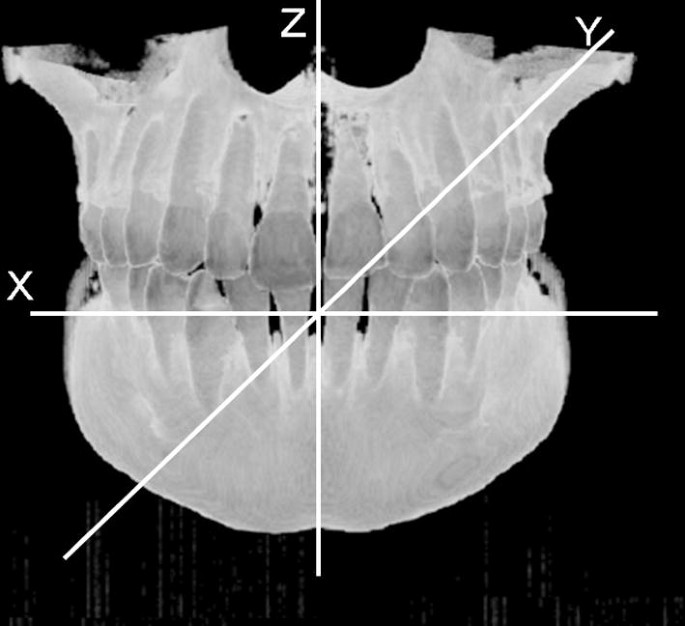
Cone-beam computed tomography paradigm and the three-dimensional coordinate organization
The algorithm for determining the tooth centrality using LSR (Fig. 2)
Stage 0:
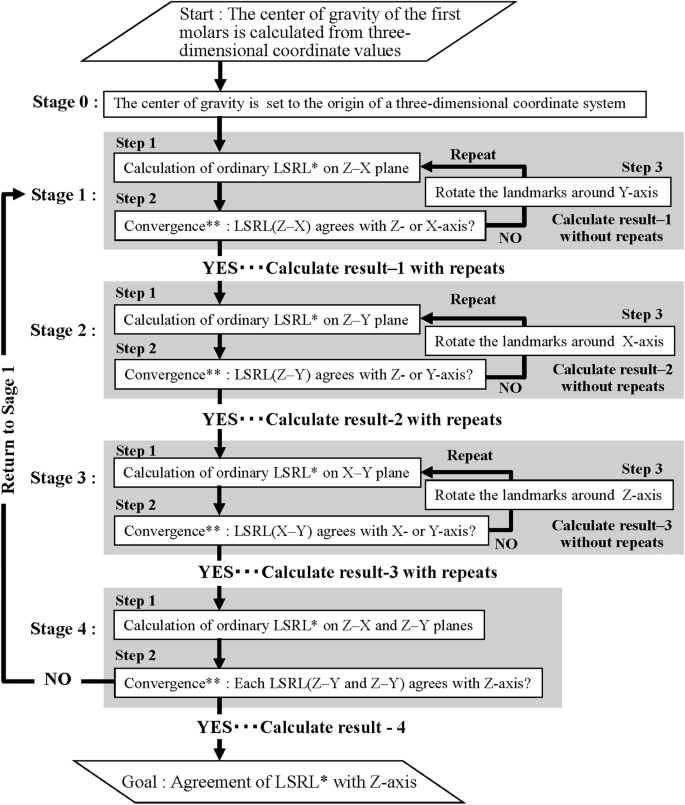
Algorithm for determining the tooth axis. *LSRL: the least square regression line. **Convergence condition: − 0.0001 <α < 0.0001. α inclination of the LSL
The center of gravity calculated from landmarks all over the molar surface was gear up as the origin in the coordinate system.
Stage ane:
The least square regression line (LSRL) was calculated from the Z and Ten coordinate values as the explanatory and objective variables, respectively (Fig. 2 phase 1, step 1). Then, the LSRL was compared with the Z axis (which represented the zero value of the regression coefficient [α ZX ]) (Fig. 2 Stage 1, Pace 2). The convergence condition was set as − 0.0001 <α ZX < 0.0001. If the LSRL did non conform to the Z centrality, all the landmarks were rotated effectually the Y centrality to make them agree (Fig. 2 Stage 1, Stride 3). Calculations were repeated until the conditions were satisfied.
Stages two and 3:
The Z coordinate values and the Y values were gear up equally the explanatory and objective variables, respectively in Stage 2 (Fig. 2 Phase two, Steps i and ii). The coordinate values were rotated around the Ten axis (Fig. 2 Stage ii, Step 3). During this process, the X coordinate values and the Y values were set every bit the explanatory and objective variables, respectively (Fig. 2 Stage 3, Steps 1 and two). The coordinate values were rotated effectually the Z axis (Fig. 2 Stage 2, Step iii). The convergence weather were the aforementioned as for Stage one. Calculations were repeated until the convergence condition was satisfied.
Stage 4:
Two LSRLs were calculated once more on the Z–X and Z–Y planes (Fig. 2 Stage iv, Step 1). All regression coefficients (α ZX , α ZY , α XY ) were checked for suitability for the convergence conditions, i.e., − 0.0001 <α < 0.0001. The estimated LSRL was converged by agreement with the Z centrality within the convergence conditions (Fig. 2 Stage 4, Step 2). If it was not suitable for the convergence conditions, it was returned to Stage 1.
The calculation was performed using the LINEST part in Microsoft Excel (version fourteen.0.7190.5000, Microsoft).
Comparison between the long axes of molars calculated past PCA and LSR
The origin in the coordinate system was fix to the center of gravity of the landmarks. The eigenvectors (Five ten , 5 y , V z ) for the PCA (Sakamoto et al. 2015) were calculated with statistical software (R and R Commander, R: version 3.4.1 and Rcmdr; version 2.4-0, The R Foundation for Statistical Computing; Vienna Academy of Engineering science, Vienna, Austria). The first primary component with the highest variance was set as the tooth axis. The PCA line (PCAL) was estimated.
Comparison between the two long axes of molars defined past LSR and PCA
The two long axes of the molars calculated past PCA and LSR were compared. It was assumed that the line estimated past LSR agreed with the Z centrality. The PCAL was moved with the same quantities and processes of rotations as the adding of the LSRL. Differences between the estimated line and the Z axis were examined.
Results
The landmarks constructed of STL files were reduced for calculation of LSR and PCA with a 3-dimensional image visualization organisation (i.e., 5657.4 and 5622.5 landmarks equally the maxillary and mandibular first molars, respectively) (Table 1, Fig. 3). There were the upper and lower two scatter diagrams on Z–Ten aeroplane (the coronal aeroplane), Z–Y plane (the sagittal plane), and Ten–Y plane (horizontal plane) from the left to the right in Fig. 3.
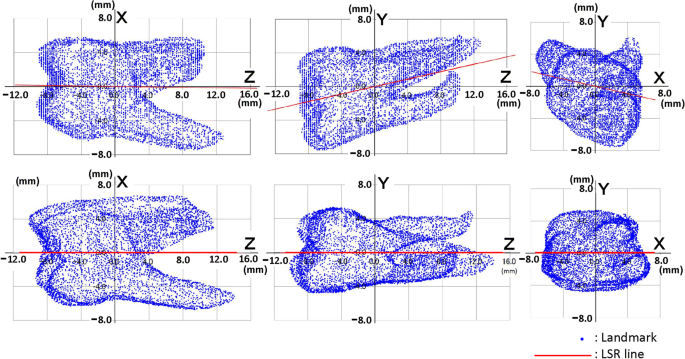
Examples of landmarks before and afterward calculation of the LSR. Upper: earlier calculation (after Phase 0) Lower: after adding (goal). The left sides: Z–X plane (the coronal plane); the middle sides: Z–Y airplane (the sagittal plane); the right sides: Ten–Y plane (horizontal plane)
Equally an example (Fig. 3), calculation of the LSRL of ane maxillary beginning molar is set out below:
Stage 0 (Fig. two Phase 0, the upper scatter diagrams in Fig. three):
The center of gravity calculated from all the landmarks of a maxillary outset molar was moved to the origin (Fig. 2 Stage 0). Tabular array ii shows the iii coefficients (α ZX , α ZY , α XY ) and intercepts (C X , C Y1, C Y2) of the LSRLs according to the algorithm (Fig. two).
Stage 1 (Fig. 2 Stage 1, Steps i–3):
The LSRL was calculated on the Z–X plane (Fig. two Stage 1, Step 1) and the inclination of this line was assessed (Fig. 2 Stage 1, Step 1). If the inclination (α ZX ) was satisfied with the convergence condition (− 0.0001 <α ZX < 0.0001), the event should accelerate to the side by side step (Fig. 2 Stage 2, Table 2 C1 without repeats). If α ZX was not satisfied, the landmarks were rotated around the Y axis (Fig. 2 Stage 1, Step 3), returning to the previous step until the convergence condition was satisfied (Fig. ii Stage 1, Footstep 1).
The inclination α ZX was reduced to − ii.69 × 10−five, and the convergence condition was satisfied (Fig. 2 summate result-1, Tabular array 2 C1 with repeats).
Phase 2 (Fig. 2 Stage 2, Steps i–3):
This procedure was also applied to the Z–Y plane and the X axis (Fig. 2 Stage 2, Steps one–3). In this stage, the inclination α ZY was reduced to − 2.23 × x−5, and the convergence condition of this phase was satisfied with an α ZX value that deviated from the Stage ane convergence status, i.e., − 6.28 × 10−2 (Fig. 2 summate event-2, Tabular array 2 C2 with repeats).
Phase 3 (Fig. 2 Stage 3, Steps ane–iii):
This process was applied to the X–Y airplane and the Z axis (Fig. two Phase iii, Steps 1–3). The inclination α XY was changed to − iii.23 × 10−5, and the convergence condition of this stage was satisfied with α ZX and α ZY values that deviated from the Stages i and ii convergence conditions, i.e., − five.17 × 10−2 and − 4.83 × 10−two, respectively (Fig. ii calculate outcome-iii, Tabular array 2 C3 with repeats).
Stage 4 (Fig. 2 Stage 4, Steps 1–iii):
Three LSRLs were calculated (Fig. ii Calculate effect-four, Tabular array 2 C4). As well as the results of Stage 3 with α values that deviated from the convergence condition, the calculation returned to Stage ane, and recalculations (Stage 1 → 2→iii → 4) were repeated until the convergence condition was satisfied.
Re: Stage 1:
3 inclinations of the LSRLs were assessed and α ZX and α ZY were not satisfied with the convergence condition (Fig. 2 Stage 4, Step 2, and Table ii C3 with repeats → C4). The calculation so returned to Stage 1 and the landmarks were rotated around the Y axis (Fig. 2 Stage i, Footstep 3). The inclination α ZX became − 3.00 × 10−5 (Table ii Re: C1 with repeats).
Re: Phase 2:
The LSRLs were calculated on the Z–Y airplane and assessed once more (Fig. ii Phase ii, Steps 1–iii). So the inclination α ZY of this phase became − 3.09 × 10−5 with α ZX of − i.94 × 10−five (Table 2 Re: C2 with repeats).
Re: Stage 3:
The LSRLs were calculated on the X–Y plane and assessed again (Fig. ii Phase 3, Steps 1–three). And then the inclination α XY of this phase became − 2.86 × ten−5 with α ZX and α ZY of − 1.94 × 10−five and − 3.09 × 10−5, respectively (Table 2 Re: C3 with repeats).
Re: Stage iv:
Iii LSRLs were calculated (Fig. two Stage iv and Table two Re: C3 with repeats → C4). All inclinations of the LSRLs were assessed and satisfied with the convergence condition (Table 2 Re: C3 with repeats → C4). It was then assessed that the LSRL agreed with the Z axis, and the long axis of this tooth was decided equally shown the lower scatter diagrams in Fig. three.
The divergence between the PCAL and the Z axis of each molar was also calculated. The differences between the PCAL and the Z axis on the 10–Y plane were two.29 × 10−xiv mm (range 2.37 × 10−fifteen to 1.11 × 10−13 mm) and 2.29 × ten−14 mm (range ii.37 × 10−15 to 1.eleven × ten−13 mm) as average values of the accented values in the X and the Y coordinate values for the maxillary first molars respectively (Tabular array 1, Fig. 4). Those for the mandibular showtime molars were seven.366 × 10−fourteen mm (range 1.34 × ten−15 to 5.85 × 10−13 mm) and 7.366 × x−14 mm (range 1.34 × ten−15 to 5.85 × 10−13 mm) as average values (Table 1). The angulations between the PCAL and the Z axes were i.489 × 10−iii (range 1.482 × 10−4 to 2.921 × x−3) degrees and i.080 × 10−3 (range ii.717 × x−four to 2.602 × 10−3) degrees as average values in the maxillary and mandibular outset molars, respectively (Tabular array 1).
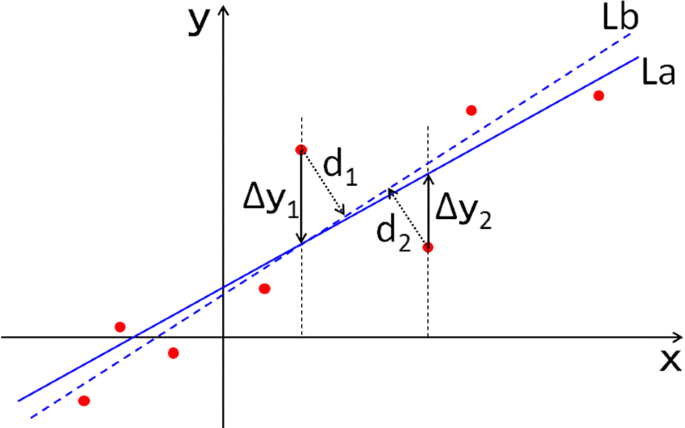
Differences between LSR and PCA. La: the line equally the sum of Δy i(i= 1, two,…north) becomes the minimum. Lb: the line as the sum of d i(i= ane, 2,…n) becomes the minimum
Discussion
Panoramic radiographs are unremarkably used to estimate the two-dimensional long axis of teeth (Shroff 2001; Owensa and Johalb 2008; Rocha et al. 2016; Garcia-Figueroa et al. 2008). With the recent demand for high-precision dental treatment such every bit dental implants, extraction of impacted teeth, and orthodontic treatment, CBCT has become increasingly of import in determining the three-dimensional condition of teeth and bones, including estimation of the three-dimensional tooth axis (Lee et al. 2015; Peck et al. 2007; Bouwens et al. 2011). In this study, nosotros estimated three-dimensional tooth axes using CBCT data taken from xx dry skulls using LSR, and found that it was possible to approximate the objective tooth axis past using the whole of the tooth surface, fifty-fifty in teeth with pocket-size surface defects such as molar attrition or dental abrasion.
Previous reports virtually determining the three-dimensional tooth axis from CBCT data used PCA (Kim et al. 2012; Sakamoto et al. 2015; Zhang et al. 2016). Therefore, we compared the iii-dimensional tooth axes defined by LSR and PCA. LSR is calculated and then that the residual sum of squares becomes the minimum on the longitudinal axis (line La in Fig. iv). PCA is calculated so that the Mahalanobis altitude becomes the minimum (line Lb in Fig. 4). Therefore, a deviation usually exists between the LSRL and the PCAL. However, the residual values are equal to the Mahalanobis distances, as the calculated line is parallel to the horizontal centrality. Then the landmarks effectually the kickoff molars are rotated, until the LSRL agrees with the horizontal axis co-ordinate to the algorithm, because the LSRL runs through the origin (Fig. 2).
It is impossible for the LSRL to agree with the horizontal axis mathematically, considering the LSRL has an mistake. So the status of the convergence was given to assess the agreement between the LSRL and the horizontal axis. The provided condition that the accented values of the inclination of the LSRL were smaller than 0.0001, was satisfied. The inclination of 0.0001 as the status of the convergence was equivalent to 0.00573°. Therefore, the maximum errors produced the inclination of 0.0001 on the Ten–Z plane and the Y–Z plane. Accordingly, the maximum error of 0.00014 at Z = 1 on the Ten–Y plane was 0.0081°.
Some studies have reported that the length from the root to the top of the crown was about 20.seven mm and 21.1 mm in the maxillary and mandibular start molars respectively (Verhoeven et al. 1979; Viecilli et al. 2013; Hikita et al. 2018). In our report, the maximum lengths were 20.6 mm and 21.4 mm in the maxillary and mandibular first molars respectively (Fig. 5a), according to the Z axis. It might then be presumed that the lengths from the eye of gravity to the occlusal surfaces are ten mm. The differences between the PCAL and the LSRL were less than 0.003 mm on the X–Y plane at Z = 10 mm (Fig. 5b), as the LSRLs were assumed to the Z centrality. These values may be smaller than the slice thickness of the CBCT. The convergence condition becomes more astringent, equally the error decreases in size. In such cases it might exist useful to estimate the long centrality of the maxillary and mandibular starting time molars with LSR.
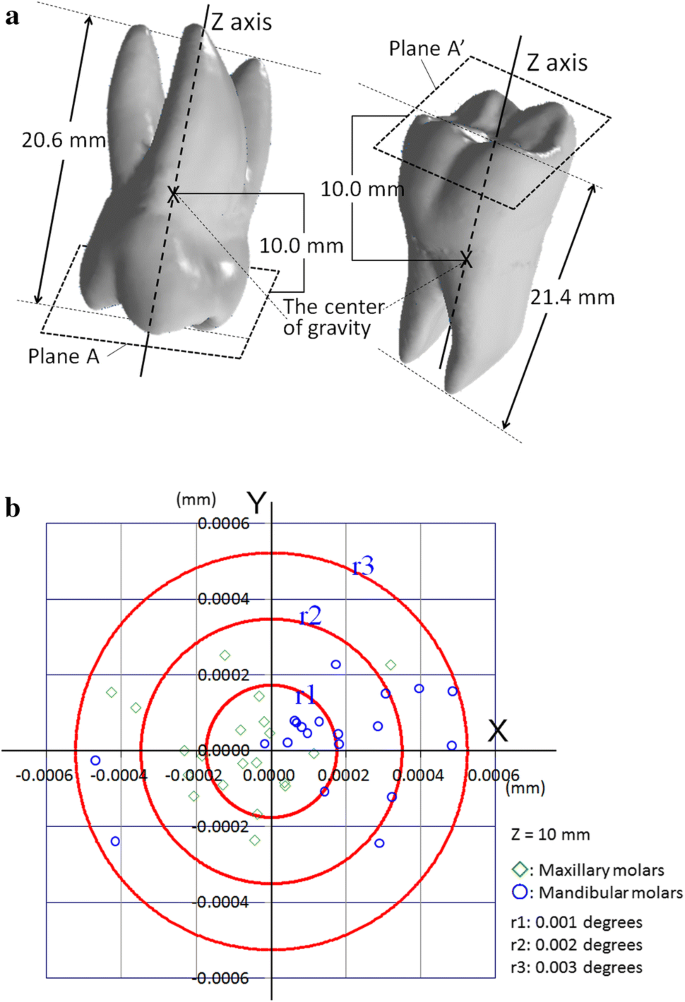
Differences betwixt PCALs and LSRLs at Z = ten mm. a The points of a scatter diagram corresponded to the molars. The PCAL and LSRL points are placed on the plane A and A′ set on Z = 10 mm from the centre of gravity of molars, which are shut to occlusal surfaces. b The scatter diagram of PCALs and LSRLS shown on the X–Y plane at Z = 10 mm
The Z axis was estimated every bit the tooth centrality, and the X–Y aeroplane could exist viewed equally the occlusal airplane. Even so, the first molars could not ever be separated into anatomical mesial and distal parts by the X–Z plane and into the buccal and lingual parts by the Y–Z aeroplane in the same mode (Fig. 6). Therefore, a new objective procedure would demand to exist considered for separation into mesial and distal or buccal and lingual parts.

An example of the occlusal surface of the mandibular molar
Dental treatment and enquiry would benefit from the easy conquering and awarding of digital dentistry, specially the utilise of three-dimensional data and its application to clinical dentistry. The individual occlusion of maxillary and mandibular molars could be assessed more precisely with knowledge of the iii-dimensional tooth axes, and this information would be indispensable for simulating the occlusion with the finite element method in future enquiry. The use of CBCT images to make up one's mind the precise positional relationship of teeth in the alveolar bone, including iii-dimensional tooth axes, would assist dentists to programme for better individual apoplexy to forestall oral frailty, resulting in improved quality of life and increased salubrious life expectancy.
Conclusion
We developed an algorithm to synchronize the LSRLs to estimate the long axes of maxillary and mandibular outset molars with multiple roots in this study. Applying this algorithm to CBCT images taken from dry skulls, the long axes of molars estimated by LSR were compared with the long axes defined with PCA.
The long axes of maxillary and mandibular first molars were estimated by using the algorithm to synchronize the LSRL with the horizontal centrality, and and then the inclination of the LSRLs approached nil. It was judged that the LSRLs agreed with the horizontal axis when the inclinations were over − 0.004 and under 0.004. These axes were compared with the axes divers with PCA, and the deviations between the two long axes were less than 0.003°. When we set more than severe convergence conditions of the α value at each stage of this LSR organisation, the distances between the LSR and PCA tooth axes could become even smaller.
Our findings suggest that the long axes of the molars estimated by LSR agree almost exactly with the axes calculated by PCA, and the degree of accurateness is sufficient for clinical usage.
References
-
Bouwens DG, Cevidanes Fifty, Ludlow JB, Phillips C (2011) Comparing of mesiodistal root angulation with posttreatment panoramic radiographs and cone-axle computed tomography. Am J Orthod Dentofac Orthop 139:126–132
-
Garcia-Figueroa MA, Raboud DW, Lam EW et al (2008) Effect of buccolingual root angulation on the mesiodistal angulation shown on panoramic radiographs. Am J Orthod Dentofac Orthop 134:93–99
-
Hikita Y, Yamaguchi T, Tomita D et al (2018) Growth hormone receptor gene is related to root length and tooth length in human being teeth. Angle Orthod 88:575–581
-
Kim One thousand, Lee J, Seo J et al (2012) Automatic teeth axes calculation for well-aligned teeth using cost profile analysis along teeth center arch. IEEE Trans Biomed Eng 59:1145–1154
-
Lee RJ, Weissheimer A, Pham J et al (2015) 3-dimensional monitoring of root motility during orthodontic handling. Am J Orthod Dentofac Orthop 147:132–142
-
Nojima K, Yokose T, Ishii T et al (2007) Tooth axis and skeletal structures in mandibular molar vertical sections in jaw deformity with facial asymmetry using MPR images. Bull Tokyo Paring Coll 48:171–176
-
Owensa AM, Johalb A (2008) Nigh-end of handling panoramic radiograph in the assessment of mesiodistal root angulation. Angle Orthod 78:475–481
-
Peck JL, Sameshima GT, Miller A et al (2007) Mesiodistal root angulation using panoramic and cone beam CT. Angle Orthod 77:206–213
-
Rocha CA, de Almeida RR, Henriques JFC et al (2016) Evaluation of long-term stability of mesiodistal centric inclinations of maxillary molars through panoramic radiographs in subjects treated with Pendulum appliance. Dental Press J Orthod 21:67–74
-
Sakamoto M, Kasuga Y, Hayashi-Sakai S et al (2015) Automatic three-dimensional tooth axis using cone beam CT. Jpn J Clin Biomech 36:119–120
-
Shroff B (2001) Root correction during orthodontic therapy. Semin Orthod seven:l–58
-
Verhoeven JW, van Aken J, van der Weerdt GP (1979) The length of teeth. A statistical analysis of the differences in length of human being teeth for radiologic purposes. Oral Surg 47:193–199
-
Viecilli RF, Budiman A, Burstone CJ (2013) Axes of resistance for molar movement: does the middle of resistance exist in 3-dimensional space? Am J Orthod Dentofac Orthop 143:163–172
-
Wheeler RC (1965) Nomenclature and general considerations, general considerations in the physiology of the permanent dentition: a textbook of dental anatomy and physiology. Saunders, Philadelphia, pp 3–26
-
Zhang D, Gan Y, Xia Z et al (2016) Molar axis estimation from computed tomography images. IEEE Trans Biomed Eng 59:1050–1053
Long Axis Of The Tooth,
Source: https://link.springer.com/article/10.1007/s12565-019-00506-1#:~:text=In%20general%2C%20the%20long%20axis,2007).
Posted by: callahanwassaimmat44.blogspot.com


0 Response to "Long Axis Of The Tooth"
Post a Comment